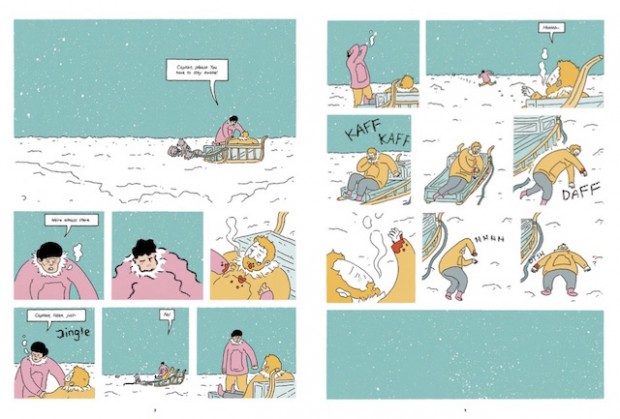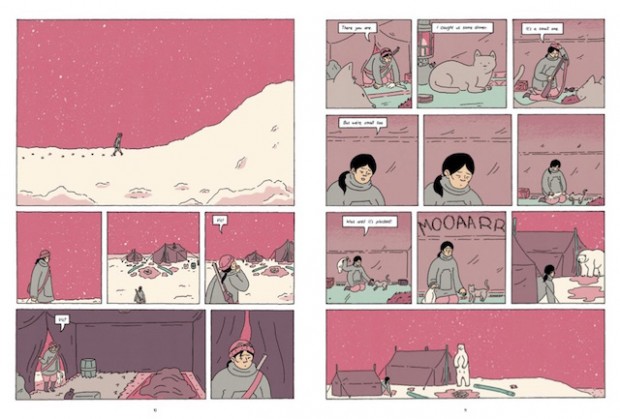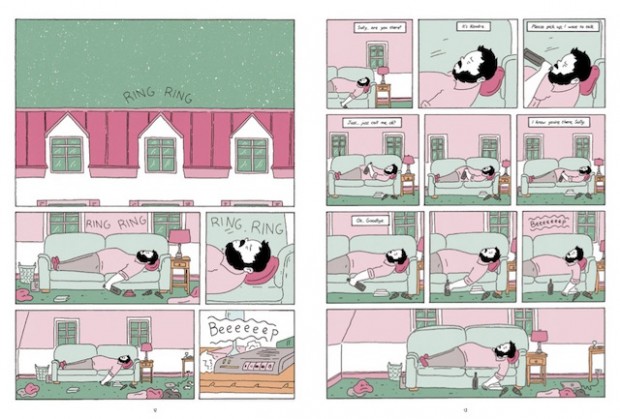“I just connected to the human story behind all of the grand adventure” Luke Healy talks arctic adventures in How To Survive In The North
 What have two unsuccessful arctic expeditions and an academic in the midst of a mid-life crisis got in common? Well they make up the three central threads of Luke Healy’s thought provoking new book, How To Survive In The North, from Nobrow Press. We caught up with Luke to find out how the world of historical explorers and fictional researchers blend together to create this unlikely of stories.
What have two unsuccessful arctic expeditions and an academic in the midst of a mid-life crisis got in common? Well they make up the three central threads of Luke Healy’s thought provoking new book, How To Survive In The North, from Nobrow Press. We caught up with Luke to find out how the world of historical explorers and fictional researchers blend together to create this unlikely of stories.
How To Survive In The North is based on a combination of historical accounts of arctic expeditions and also the story of a fictitious academic researching both stories, can you tell us a bit about the inspiration for telling this story? Which part of the story came first?
LH: It’s sort of a funny story, actually. About four years ago, I was working on an application to The Center for Cartoon Studies (CCS), the place where I studied cartooning. As a part of this application, I had to complete a short comic that met certain criteria. I made a comic about a character who was travelling all around the world, and I needed some reference photos of people from different places. I was googling reference photos of Inuit people, and villages, when I came across a pretty striking photo of a woman. I clicked through to the source, and it was the photo from Ada Blackjack’s wikipedia page. I read her story, and remember thinking that it was interesting, but sort of just filed it away in the back of my mind.
Then, years later, when I was working on my thesis at CCS, I remembered her story and decided that I should adapt it into comic form as a part of the project. When I looked up more information about her, I discovered that all of the primary sources of information about her expedition were in a library only five minutes away. It was such a huge coincidence, that I knew I had to go forward with the comic.
After researching more, I kept coming across mentions of the Robert Bartlett expedition, and I decided that the relationship between these two expeditions was so interesting, that I needed to write about both of them. The third, fictional narrative was added because I knew I wanted to add further context about the aftermath of these two real expeditions, but I also didn’t want to break from the perspective of the two protagonists. Eventually, this third narrative became more thematically related, than anything else, which I prefer. It seems less heavy handed to me.

Did you have to do much research into the historical accounts to get it accurate? Or is it subject which is a real passion for you?
LH: I spent a lot of time researching the circumstances of these expeditions. I had really phenomenal access to many of the original documents that they generated, so it seemed a shame to not be as thorough as possible. The best item I had access to was definitely Ada Blackjack’s original handwritten diary that she kept while stranded on Wrangel Island. It seemed insane that I could handle all of these almost century old documents. Ada’s diary was flaking apart as I turned the pages. And here it was, this remarkable account of a person’s life, just sitting in a box in a library that anyone could check out.
Before working on this project, I had basically no interest in the subject of Arctic exploration. More than anything I think I just connected to the human story behind all of the grand adventure.
Why did you chose to go for this three pronged story approach rather than focus on just one? Ada and Robert are both such strong character on their own, so why not focus on just the one?
LH: Frankly, I wanted to challenge myself. I think the relationship between the expeditions is fascinating, but mostly, I wanted to push my writing to see if I could make this more complicated narrative structure work. But ultimately highlighting the similarities and differences between these expeditions, I think, gives the stories a broader context, and greater emotional depth. Would the men on Ada’s expedition have walked out onto the Arctic ice if one of them hadn’t seen Captain Bartlett successfully do the same only a few years earlier? Would Stefansson have launched another expedition if he had been around to see the disaster on the Karluk? These questions can only be raised by paralleling the two expeditions, and to me they’re some of the most interesting elements of the book.

Did you always know you wanted (or needed) the story to connect together? Or was that the initial appeal of basing your story around those two events?
LH: Yeah, the choice to interweave the multiple stories came about pretty early in the process, shortly after I began researching Ada Blackjack’s story.
The story of Sully the academic feels like the lynchpin for the story, how important was it for you to make his relationship with a student a same-sex relationship? Does that make it more sensational for an academic and a student, or was that not an issue?
LH: I find it interesting that you feel that way. For me, Ada Blackjack’s story was always at the centre of the book, not that the others have less attention or focus, but hers was always the emotional centre for me.
I tried to make the fact that the 2013 story revolves around a same-sex relationship a non-issue. I do think that it unavoidably changes the dynamic of their relationship, and their situation, but mostly I chose not to make it an issue in the narrative.
Though I’m sure that if you wanted to analyse the book as a story about power in relationships, the same sex nature of their relationship would certainly be an important point to raise, but hey, that’s not my job!

We loved the colour scheme you used to help differentiate each story strand. Was that something you intended to do all along? Do the colours have any partcicular significance? And were the northern lights that you use as a colour palette in the opening spread, the source of this?
LH: Yes, I always intended to use colour to differentiate the three strands. They don’t hold any narrative significance though! I just wanted them to look good. The three intertwining colours of the northern lights are indeed supposed to reflect the three intertwining stories.
If readers are new to your work, what else should they be checking out and what can we look forward to from you next?
LH: There is lots of work available for free on my website www.lukewhealy.com. Maybe check out the comic Of the Monstrous Pictures of Whales, it won a prize. People seem to like that one!
As for what’s coming next, I finished up a new comic a couple of months ago called The Unofficial Cuckoo’s Nest Study Companion. I’m really proud of it. It should see publication later this year!
You can purchase How To Survive In The North from Nobrow Press


